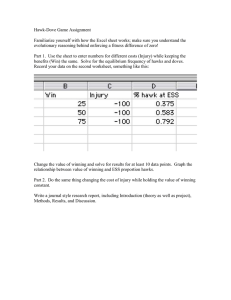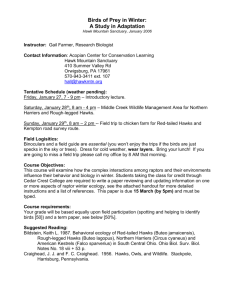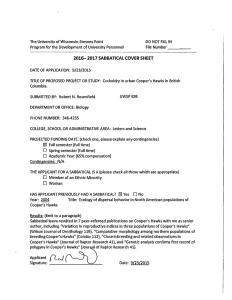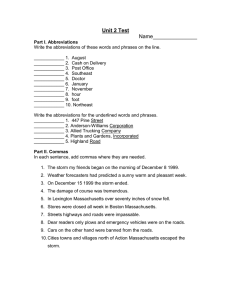j.1472-4642.2008.00475.x.doc
advertisement
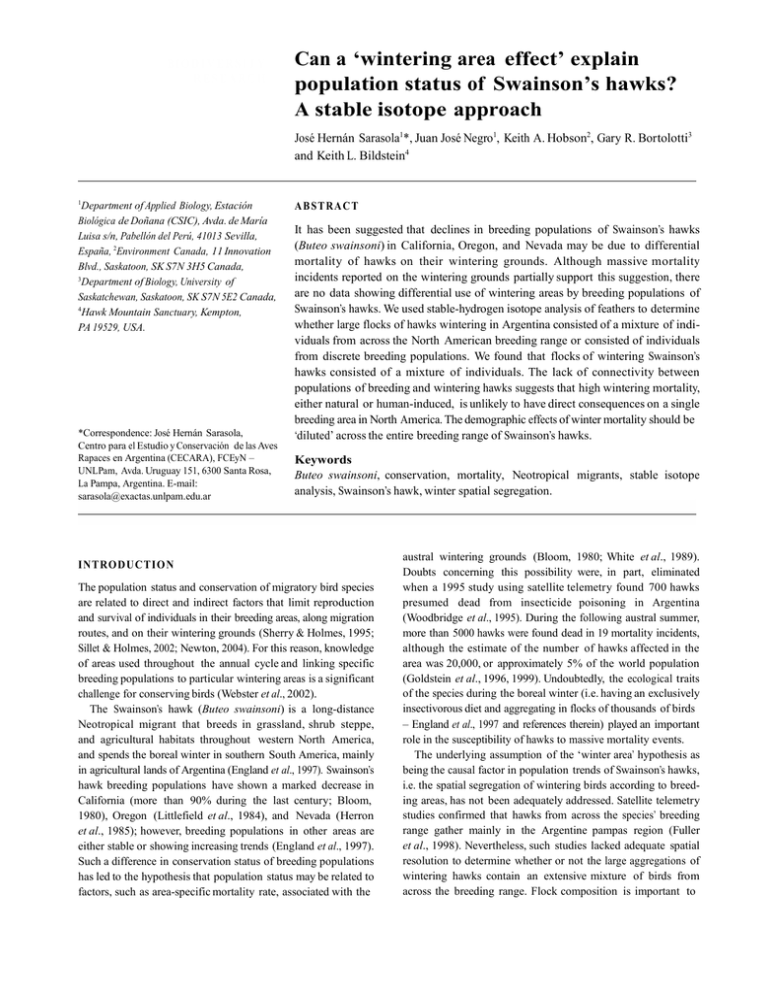
Blackwell Publishing Ltd BIODIVERSITY RESEARCH Can a ‘wintering area effect’ explain population status of Swainson’s hawks? A stable isotope approach José Hernán Sarasola1*, Juan José Negro1, Keith A. Hobson2, Gary R. Bortolotti3 and Keith L. Bildstein4 1 Department of Applied Biology, Estación Biológica de Doñana (CSIC), Avda. de María Luisa s/n, Pabellón del Perú, 41013 Sevilla, España, 2Environment Canada, 11 Innovation Blvd., Saskatoon, SK S7N 3H5 Canada, 3 Department of Biology, University of Saskatchewan, Saskatoon, SK S7N 5E2 Canada, 4 Hawk Mountain Sanctuary, Kempton, PA 19529, USA. *Correspondence: José Hernán Sarasola, Centro para el Estudio y Conservación de las Aves Rapaces en Argentina (CECARA), FCEyN – UNLPam, Avda. Uruguay 151, 6300 Santa Rosa, La Pampa, Argentina. E-mail: sarasola@exactas.unlpam.edu.ar A B ST R A C T It has been suggested that declines in breeding populations of Swainson’s hawks (Buteo swainsoni) in California, Oregon, and Nevada may be due to differential mortality of hawks on their wintering grounds. Although massive mortality incidents reported on the wintering grounds partially support this suggestion, there are no data showing differential use of wintering areas by breeding populations of Swainson’s hawks. We used stable-hydrogen isotope analysis of feathers to determine whether large flocks of hawks wintering in Argentina consisted of a mixture of individuals from across the North American breeding range or consisted of individuals from discrete breeding populations. We found that flocks of wintering Swainson’s hawks consisted of a mixture of individuals. The lack of connectivity between populations of breeding and wintering hawks suggests that high wintering mortality, either natural or human-induced, is unlikely to have direct consequences on a single breeding area in North America. The demographic effects of winter mortality should be ‘diluted’ across the entire breeding range of Swainson’s hawks. Keywords Buteo swainsoni, conservation, mortality, Neotropical migrants, stable isotope analysis, Swainson’s hawk, winter spatial segregation. INTRODUCTIO N The population status and conservation of migratory bird species are related to direct and indirect factors that limit reproduction and survival of individuals in their breeding areas, along migration routes, and on their wintering grounds (Sherry & Holmes, 1995; Sillet & Holmes, 2002; Newton, 2004). For this reason, knowledge of areas used throughout the annual cycle and linking specific breeding populations to particular wintering areas is a significant challenge for conserving birds (Webster et al., 2002). The Swainson’s hawk (Buteo swainsoni) is a long-distance Neotropical migrant that breeds in grassland, shrub steppe, and agricultural habitats throughout western North America, and spends the boreal winter in southern South America, mainly in agricultural lands of Argentina (England et al., 1997). Swainson’s hawk breeding populations have shown a marked decrease in California (more than 90% during the last century; Bloom, 1980), Oregon (Littlefield et al., 1984), and Nevada (Herron et al., 1985); however, breeding populations in other areas are either stable or showing increasing trends (England et al., 1997). Such a difference in conservation status of breeding populations has led to the hypothesis that population status may be related to factors, such as area-specific mortality rate, associated with the austral wintering grounds (Bloom, 1980; White et al., 1989). Doubts concerning this possibility were, in part, eliminated when a 1995 study using satellite telemetry found 700 hawks presumed dead from insecticide poisoning in Argentina (Woodbridge et al., 1995). During the following austral summer, more than 5000 hawks were found dead in 19 mortality incidents, although the estimate of the number of hawks affected in the area was 20,000, or approximately 5% of the world population (Goldstein et al., 1996, 1999). Undoubtedly, the ecological traits of the species during the boreal winter (i.e. having an exclusively insectivorous diet and aggregating in flocks of thousands of birds – England et al., 1997 and references therein) played an important role in the susceptibility of hawks to massive mortality events. The underlying assumption of the ‘winter area’ hypothesis as being the causal factor in population trends of Swainson’s hawks, i.e. the spatial segregation of wintering birds according to breeding areas, has not been adequately addressed. Satellite telemetry studies confirmed that hawks from across the species’ breeding range gather mainly in the Argentine pampas region (Fuller et al., 1998). Nevertheless, such studies lacked adequate spatial resolution to determine whether or not the large aggregations of wintering hawks contain an extensive mixture of birds from across the breeding range. Flock composition is important to Spatial segregation of wintering Swainson’s hawks establish because insecticide poisoning (e.g. Woodbridge et al., 1995; Goldstein et al., 1996) and natural sources of winter mortality for Swainson’s hawks (e.g. hailstorms; Sarasola et al., 2005) are local events in small (e.g. an agricultural plot or a grove where hawks roost) rather than broad-scale phenomena covering a large area. In this study, we estimated the breeding origins of Swainson’s hawks at a wintering site in the Argentine pampas, and assessed the spatial segregation of the birds by analysing deuterium levels in feathers. The development of laboratory techniques that rely on intrinsic tissue signatures of stable isotopes to trace migratory origins of birds has led to a great advance in understanding the ecology of migratory birds (see review by Hobson, 2005). Stable isotopes are fixed in animal tissues through food webs and ultimately reflect the isotopic features of the environment where tissues developed. Feathers are especially useful tissues for stable isotope studies because they are metabolically inert after the initial deposition of keratin and isotopic information is ‘locked in’ until tissue turnover (i.e. molt) (Hobson, 2005). Because natural isotopic patterns vary from one site to another, birds moving from an area with known isotopic signals to another will retain in their feathers the isotopic information from their site of origin, allowing tracking of bird origins and movements. For the New World, stable-hydrogen isotope analyses (i.e. δD) have proved to be successful in establishing geographical connectivity for Neotropical migrant songbirds (Hobson & Wassenaar, 1997; Rubenstein et al., 2002) and raptors (Meehan et al., 2001). We applied this methodology to determine whether or not large groups of hawks in wintering areas were formed by extensive mixing of individuals across the breeding range and, subsequently, to examine the plausibility of winter mortality as a causal effect on current trends of breeding populations. METHOD S Study area and feather sampling We obtained feather samples from free-living Swainson’s hawks captured at five roost sites located throughout the Argentine pampas. This region encompasses c. 45 million hectares of flat landscapes suitable for cattle ranching and crop cultivation. Although small numbers of Swainson’s hawks winter in other Central and South American countries (e.g. Colombia, southern Brazil, Uruguay, and Paraguay – England et al., 1997), and also in southern Florida, California, and México (Herzog, 1996; Wheeler, 2003), satellite telemetry studies have identified the Argentine pampas as the main wintering range for the species. In 1995–96, 34 Swainson’s hawks from the entire breeding range in North America, including seven US states and two Canadian provinces, were fitted with satellite transmitters. Of the 27 birds that completed their southward migration, all reached the Argentine pampas (Fuller et al., 1998). In addition, two adult females satellite-tagged on their breeding grounds in California during 1994 also migrated to the Argentine pampas (Woodbridge et al., 1995). Band recoveries during November to March also confirm Argentina as the main winter destination of migrant Swainson’s hawks. Of 16 band recoveries from birds banded in Saskatchewan (Canada), 13 were from Argentina, one from Uruguay and the remaining two from El Salvador (Houston, 1990). Band returns of Swainson’s hawks for Wyoming, Colorado, California, and Alberta also come from Argentina (White et al., 1989; Houston & Schmutz, 1995). The five austral sampling sites were distributed in three Argentinean provinces; one of them was near the town of Las Varillas (LV, 31°58′ S, 62°50′ W), Córdoba province; three roosts were in La Pampa province – one near the Villa Mirasol town (VM, 36°4′ S, 36°52′ W), one at the Chanilao ranch (CHA, 35°14′ S, 63°57′ W) and one near the city of Santa Rosa (SR, 36°33′ S, 64°07′ W). The remaining site was located near the town of Guaminí (GUA, 36°48′ S, 62°19′ W) in the Buenos Aires province. Mean distance between roost sites was 288 km (min = 73 km, max = 589 km). The habitat where trapping was conducted comprised crop fields, principally soybeans and sunflowers, mixed with planted pastures and natural fields. Hawks were captured in open fields near the roost using bal-chatri traps (Berger & Mueller, 1959) in early morning and during the afternoon. Traps were baited with mice and set in front of fence posts used by hawks for perching. One of the key elements in designing stable isotope studies is the establishment of unequivocal links between the type of animal tissue being examined and the area in which the tissue was developed or grown (Rubenstein & Hobson, 2004). For studies linking breeding and wintering populations of birds, feathers are suitable tissues if they are not grown in the same locale as where sampled, i.e. feathers should be grown on the breeding grounds if sampling is conducting in wintering quarters. Such degree of certainty requires a detailed knowledge of the moulting cycle for the species. Until recently, it was thought that Swainson’s hawks only moulted in their breeding areas and retained all feathers during the non-breeding season until their return to the breeding sites (Schmutz, 1992). Recently, Bechard & Weidensaul (2005) have highlighted the fact that Swainson’s hawks also moult while wintering, but a complete analysis of the moulting cycle is still lacking. For our study, we selected only those Swainson’s hawks that could be reliably aged as hatchingyear birds according to Wheeler & Clark (1995). Therefore, we were certain that the feathers analysed had grown in the breeding areas just a few months before they were sampled in wintering areas and before any moult had taken place. In addition, we analysed feathers from nestling Swainson’s hawks sampled near Saskatoon (Saskatchewan, Canada). This latter sample provided standard values of isotopic signatures for birds of a known and precise breeding site. A blood sample was taken for the hawks captured on the wintering grounds for sex determination and stored in 96% ethanol until analysis following standard molecular procedures (for further details see Sarasola & Negro, 2004). Stable isotope analyses Feathers were cleaned of surface oils using a 2 : 1 chloroform:methanol solution and allowed to air-dry. Single feathers were weighed out into silver capsules. Stable isotope analyses of the non-exchangeable hydrogen of feathers was conducted using online continuous-flow isotope ratio mass spectrometry (CFIRMS) performed on a Micromass Optima dual-inlet isotope ratio mass spectrometer (Micromass UK, Manchester, UK) as described in detail by Wassenaar & Hobson (2003). Deuterium values are expressed in the delta notation, in units per thousand (‰), and normalized on the VSMOW-SLAP standard scale. Reproducibility of CF-IRMS conducted in the Environment Canada laboratory (Saskatoon) and based on internal standards is ≤ 2.0‰ (Wassenaar & Hobson, 2003). Similar to Wassenaar & Hobson (2001), we used an offset (cumulative isotopic discrimination factor) between mean growing-season precipitation δD and feather non-exchangeable δD of +25‰ to relate feather δD values with known North American growing season average precipitation δD values. Statistical analysis We computed 50% and 75% tolerance limits at a 95% confidence level (Walpole & Myers, 1992) for δD feather values to estimate the breeding origin range of birds sampled in wintering grounds. Limits of breeding areas were constrained by the boundaries of geographical range of the species and by the 50% and 75% tolerance limits of δDf values. Consequently, the areas falling within the 50% and 75% tolerance intervals of δDf reflect areas from which 50% and 75% of the individuals sampled at each of the roosting sites in wintering grounds originated, respectively. Breeding areas were generated using the geographical information system (GIS)-based model of δDf values developed for raptors by Lott & Smith (2006). We employed an ANOVA test to evaluate differences in breeding origins of birds wintering in different areas and a two-way factorial ANOVA to test simultaneously for site- and sex-related differences in breeding origins of wintering hawks. We performed a Mantel test (Legendre & Legendre, 1998) to check for spatial autocorrelation of δDf values between sampling sites. For this procedure we built separate matrices of geographical distances between roost sites sampled and absolute differences in mean δDf values among sampling sites. By doing so we explore the propensity of roost sites in close proximity to host birds with more similar breeding origins than those located far away from each other (i.e. significant positive correlation between geographical and mean value distances). Significance of the autocorrelation coefficient was tested by resampling methods using n = 9999 randomizations. RE SULT S In total, 104 hawks were captured during the 2003 and 2004 austral summers (for details see Sarasola & Negro, 2004) at the five roost sites. The subsample of birds hatched in the preceding season consisted of 40 hawks: 12 from LV in Córdoba province; four, seven, and 13 birds from VM, CH, and SR in La Pampa province and four hawks from GUA in Buenos Aires province (Table 1). Differences between mean isotopic signatures of feathers between roosts were not significant (F4,35 = 1.35, P = 0.27). Neither Table 1 Site- and sex-specific mean (± standard deviation (SD)) δDf values (‰) for flocks of Swainson’s hawks sampled in wintering areas of Argentina. For samples obtained in a breeding area in Saskatchewan only global values without sex differentiation are provided. Male Female Site Mean (SD) n LV VM CHA SR GUA SASK –79.4 (47.8) 7 –23.8 (1.8) 2 –3.2 1 –68.1 (40.3) 10 –49.4 (35.7) 3 – – Mean (SD) Total n –49.0 (49.0) 5 –100.4 (31.6) 2 –33.2 (29.8) 6 –89.7 (56.0) 3 –64.4 1 – – Mean (SD) n –66.7 (48.6) 12 –62.1 (47.9) 4 –28.9 (29.5) 7 –73.1 (42.8) 13 –53.2 (30.1) 4 –136.5 (7.3) 17 LV = Las Varillas, Córdoba; VM = Villa Mirasol, La Pampa; CHA = Chanilao Ranch, La Pampa; SR = Santa Rosa, La Pampa; GUA = Guaminí, Buenos Aires; SASK = Saskatoon, Canada. Figure 1 Relationship between distance (km) and differences of mean values of δD (‰) signatures in feathers of Swainson’s hawks captured at each of the five roost sites in the wintering grounds. site (F2,23 = 0.34, P = 0.71) nor sex (F1,23 = 1.31, P = 0.26) nor the interaction between these factors (F2,23 = 2.39, P = 0.11) was significant when tested for those sampling sites with adequate sample sizes (see Table 1). There was no relationship between roost sites distance and mean δDf difference between sites (Mantel test, Ro = –0.40, P = 0.80, Fig. 1). Feather δD values for wintering hawks corresponded to latitudes that encompassed almost the entire range of the species in North America (Fig. 2). Compared with the coefficient of variation obtained for the breeding-site control sample from Saskatchewan (CV = 5%), roost site variability in δDf values for wintering hawks was between 11 and 19 times greater (CV range = 56–102%) than the expected CV for groups of birds coming from the same breeding area. t Spatial segregation of wintering Swainson’s hawks Figure 2 Breeding areas of Swainson’s hawks captured and sampled in five roost sites in the Argentine pampas. Limits of the breeding areas were constrained by the boundaries of geographical range of the species and by the 50% and 75% tolerance limits of δDf values (‰). Estimates were based using a GIS-based model of δDf values (Lott & Smith, 2006). DISCUSSIO N Understanding levels of geographical connectivity between breeding and wintering populations is a prerequisite for conservation of migrant bird species (Webster et al., 2002; Pérez & Hobson, 2007). Stable-hydrogen isotope analysis of feathers of wintering Swainson’s hawks revealed that roosting flocks in the Argentine pampas are comprised of an extensive mixture of bird with origins from across the species’ Nearctic breeding range. Our results reliably showed that there was a lack of spatial segregation of wintering hawks by sex, with values of δDf showing a great overlap between males and females at each of the roost sites. Massive mortalities of Swainson’s hawks on the wintering grounds have obvious impacts on overall population numbers. However, the lack of winter segregation of Swainson’s hawks according to either their breeding origin or by sex reveals that high wintering mortality, either natural or human-induced, is unlikely to have disproportionate consequences on a single breeding population. Rather, the demographic effects of wintering mortality are predicted to be diluted across the entire breeding range. Our results suggest that negative trends observed in breeding populations of Swainson’s hawks in the northern hemisphere are unlikely to be attributable exclusively to a ‘wintering area’ effect. Rather, the species’ conservation status may reflect a combination of winter- and breeding-area effects. For example, studies describing the genetic diversity and population structure of Swainson’s hawks throughout their range in North America have found a heterozygote excess indicative of a recent reduction in the effective population size across all regions (Hull et al., 2007). This recent, range-wide bottleneck in effective population size of Swainson’s hawks is probably linked to European settlement in North America during the 19th and 20th centuries and to subsequent anthropogenic factors (e.g. habitat alteration, persecution), but it is also in agreement with the expected, broadly spread demographic consequences of hawk mortalities occurring in Argentina. Recent studies using satellite transmitters have document that a large fraction of the Swainson’s hawk population in Central Valley, California, one of which experienced the most severe demographic decline during the last century, also over winters along the Pacific slope of Mexico (Wheeler, 2003). It is unknown, however, at which extent this is just a recently documented but largely used wintering area or a recent shift in the migratory pattern for this population. If so, any case of hawk mortality in these ‘new’ areas is surely unrelated to a century of Swainson’s hawk population decline in California. Furthermore, individuals from other North American nesting populations are likely wintering in this area as well. Regardless of the underlying process and its temporal extend, the number of hawks spending the boreal winter in this and other recently reported wintering areas is small (e.g. 30 individuals wintering regularly in Sacramento-San Joaquin River Delta in California – Herzog, 1996), specially when compared with hundreds of thousands of Swainson’s hawks wintering in South America in accordance with hawks counted in Veracruz (Mexico) (England et al., 1997). Local processes or factors having a negative effect on breeding performance or hawk abundance may be varied, e.g. prey availability (Schmutz & Hungle, 1989), interspecific competition, habitat loss or fragmentation (Littlefield et al., 1984), and exposure to pesticides (Bechard, 1981; Risebrough et al., 1989; Kirk & Hyslop, 1998). In the same way, localized increases in breeding populations of Swainson’s hawks, such as those reported in north-central Oregon (Janes, 2003) and Canada (Schmutz & Hungle, 1989), cannot be attributed solely to measures taken in Argentina to ban highly toxic pesticides and to mitigate negative effects of agricultural practices on wintering hawks. During the austral summer of 1996–97, mortality incidents involving Swainson’s hawks occurred in a well-delimited area of the pampas region that covers approximately 2500 km2 in northwestern La Pampa province. This clumped distribution of poisoning events was probably related to the combination of several factors (high temperatures, land-use types, and their associated agricultural practices) that determine grasshopper outbreaks and the subsequent improper use of organophosphate insecticides. Therefore, Swainson’s hawks that were occupying this region were more affected by these mortality incidents than those occupying areas elsewhere in the Argentine pampas. Our assessment provides some insights into the effects of winter Swainson’s hawks mortality on current population trends and conservation status of breeding populations and on the expectable spatial extent of the effects of such mortality events on the demography and abundance of hawks in breeding areas as well. Furthermore, these results show the usefulness of stable isotope analysis as a tool to recognize breeding- and winter-causal effects on conservation of long-distance migratory birds. ACK NO W LE DG E ME N T S We are grateful to Verónica Salvador, Miguel Santillán, Maximiliano Galmes, Beltrán Gómez, Marc Bechard, and Noah Witheman for their valuable help in trapping and sampling Swainson’s hawks in Argentina. We also thank Marc Bechard and Brian Woodbridge for help in ageing hawks and Marten Stoffel for supplying samples from Canada. We thank Professor David Richardson and four anonymous reviewers for their comments on the article. Agustín Lanusse, Silvina Salva, Maximiliano Alliaga, Jorgelina Montoya, Carlos Alliaga, Jorge Urruspuru, and Jorge Ulloa provided logistic support and gave permission for trapping hawks in their ranches. Steve van Wilgenburg provided valuable GIS and technical support to depict origins of Swainson’s Hawks in North America. Financial support to this research was provided by the Wildlife Conservation Society (USA) throughout a Research Fellowship of the International Conservation Program, the Hawk Mountain Sanctuary through a Soar Grant Program and the Banco Río-Universia. While conducting this research, JHS was supported by a scholarship from Consejo Nacional de Investigaciones Científicas y Técnicas de Argentina (CONICET). GRB was supported by NSERC. This is Hawk Mountain Sanctuary contribution to conservation science number 166. REF ERE NC ES Bechard, M.J. (1981) DDT and hexachlorobenzene residues in southeastern Washington Swainson’s hawks (Buteo swainsoni). Bulletin of Environmental Contamination and Toxicology, 26, 248 –253. Bechard, M.J. & Weidensaul, C.S. (2005) Feather molt by Swainson’s hawks (Buteo swainsoni) on the Austral grounds of Argentina. Ornitología Neotropical, 16, 267–270. Berger, D.D. & Mueller, H.C. (1959) The bal-chatri: a trap for the birds of prey. Bird Banding, 30, 18 –26. Bloom, P.H. (1980) The status of the Swainson’s hawk in California, 1979. Final Report II-8.0, Bureau of Land Management and Federal Aid in Wildlife Restoration, California Department of Fish and Game, Sacramento, California, 42 pp. England, A.S., Bechard, M.J. & Houston, C.S. (1997) Swainson’s hawk (Buteo swainsoni). The birds of North America (ed. by A. Poole and F. Gill), No. 265. Academy of Natural Sciences, Philadelphia, PA, and The American Ornithologists Union, Washington, D.C. Fuller, M.R., Seegar, W.S. & Schueck, L.S. (1998) Routes and travel rates of migrating Peregrine Falcons Falco peregrinus and Swainson’s hawks Buteo swainsoni in the Western Hemisphere. Journal of Avian Biology, 29, 433–440. Goldstein, M.I., Woodbridge, B., Zaccagnini, M.E., Canavelli, S.B. & Lanusse, A. (1996) An assessment of mortality of Swainson’s hawks in wintering grounds in Argentina. Journal of Raptor Research, 30, 106–107. Goldstein, M.I., Lacher, T.E., Woodbridge, B., Bechard, M.J., Canavelli, S.B., Zaccagnini, M.E., Cobb, G.P., Scollon, E.J., Tribolet, R. & Hooper, M.J. (1999) Monocrotophos-induced mass mortality of Swainson’s hawks in Argentina, 1995–96. Ecotoxicology, 8, 201–214. Herron, G.B., Mortimer, C.A. & Rawlings, M.S. (1985) Nevada raptors: their biology and management. Biological Bulletin no. 8, Nevada Department of Wildlife, Reno, Nevada. Herzog, S.L. (1996) Wintering Swaison’s hawks in California’s Sacramento-San Joaquin River Delta. Condor, 98, 876 – 879. Hobson, K.A. (2005) Using stable isotopes to trace long-distance dispersal in birds and other taxa. Diversity and Distributions, 11, 157–164. Hobson, K.A. & Wassenaar, L.I. (1997) Linking breeding and wintering grounds of Neotropical migrant songbirds using stable hydrogen isotopic analysis of feathers. Oecologia, 109, 142–148. Houston, C.S. (1990) Saskatchewan Swainson’s hawks. American Birds, 44, 215–220. Houston, C.S. & Schmutz, J.K. (1995) Swainson’s hawk banding in North America to 1992. North American Bird Bander, 20, 120–127. Hull, J.M., Anderson, R., Bradbury, M., Estep, J.A. & Ernest, H.B. (2007) Population structure and genetic diversity in Swainson’s hawks (Buteo swainsoni): implications for conservation. Conservation Genetics, doi: 10.1007/s10592-007-9342-y. Janes, S.W. (2003) Breeding populations of Swainson’s hawks, red-tailed hawks and golden eagles in north central Oregon: 1975–82 and 1999. Western North American Naturalist, 63, 363–365. Kirk, D.A. & Hyslop, C. (1998) Population status and recent trends in Canadian raptors: a review. Biological Conservation, 83, 91–118. Legendre, P. & Legendre, L. (1998) Numerical ecology, 2nd edn. Elsevier, Amsterdam. Littlefield, C.D., Thompson, S.P. & Bradley, D.E. (1984) History and present status of Swainson’s hawks in southeast Oregon. Journal of Raptor Research, 18, 1–5. Lott, C. & Smith, J.P. (2006) A geographic-information-system approach to estimating the origin of migratory raptors in North America using stable hydrogen isotope ratios in feathers. The Auk, 123, 822–835. Meehan, T.D., Lott, C.A., Sharp, Z.D., Smith, R.B., Rosenfield, R.N., Stewart, A.C. & Murphy, R.K. (2001) Using hydrogen isotope geochemistry to estimate the natal latitudes of immature Cooper’s hawks migrating through the Florida Keys. Condor, 103, 11–20. Newton, I. (2004) Population limitation in migrants. Ibis, 146, 197–226. t Spatial segregation of wintering Swainson’s hawks Pérez, G.E. & Hobson, K.A. (2007) Feather deuterium measurements reveal origins of migratory western loggerhead shrikes (Lanius ludovicianus excubitorides) wintering in Mexico. Diversity and Distributions, 13, 166–171. Risebrough, R.W., Schlorff, R.W., Bloom, P.H. & Littrell, E.E. (1989) Investigations of the decline of Swainson’s hawk populations in California. Journal of Raptor Research, 23, 63–71. Rubenstein, D.R. & Hobson, K.A. (2004) From birds to butterflies: animal movement patters and stable isotopes. Trends in Ecology and Evolution, 19, 256–263. Rubenstein, D.R., Chamberlain, C.P., Holmes, R.T., Ayres, M.P., Waldauer, J.R., Graves, G.R. & Tuross, N.C. (2002) Linking breeding and wintering ranges of a migratory songbird using stable isotopes. Science, 295, 1062–1065. Sarasola, J.H. & Negro, J.J. (2004) Gender identification in the Swainson’s hawk Buteo swainsoni using molecular procedures and discriminant function analysis. Journal of Raptor Research, 38, 357–361. Sarasola, J.H., Negro, J.J., Salvador, V. & Maceda, J.J. (2005) Hailstorms as cause of mass mortality of Swainson’s hawks in their wintering grounds. Journal of Wildlife Diseases, 41, 643–646. Schmutz, J.K. (1992) Molt of flight feathers in ferruginous and Swainson’s hawks. Journal of Raptor Research, 26, 124–135. Schmutz, J.K. & Hungle, D.J. (1989) Populations of ferruginous and Swainson’s hawks increase in synchrony with ground squirrel. Canadian Journal of Zoology, 67, 2596 –2601. Sherry, T.W. & Holmes, R.T. (1995) Summer versus winter limitations of populations: what are the issues and what the evidences? Ecology and management of Neotropical migratory birds (ed. by T.E. Martin and D.M. Finch), pp. 85–120. Oxford University Press, Oxford, UK. Sillet, T.S. & Holmes, R.T. (2002) Variation in survivorship of a migratory songbird throughout its annual cycle. Journal of Animal Ecology, 71, 296–308. Walpole, R.E. & Myers, R.H. (1992) Probability and statistics for engineers and scientists, 5th edn. Prentice Hall, Englewood Cliff, New Jersey. Wassenaar, L.I. & Hobson, K.A. (2001) A stable-isotope approach to delineate geographical catchment areas of avian migration monitoring stations in North America. Environmental Science and Technology, 35, 1845–1850. Wassenaar, L.I. & Hobson, K.A. (2003) Comparative equilibration and online technique for determination of nonexchangeable hydrogen of keratins for use in animal migration studies. Isotopes in Environmental and Health Studies, 39, 211–217. Webster, M.S., Marra, P.P., Haig, S.M., Bensch, S. & Holmes, R.T. (2002) Links between worlds: unravelling migratory connectivity. Trends in Ecology and Evolution, 17, 76–83. Wheeler, B.K. (2003) Raptors of western North America. Princeton University Press, Princeton, New Jersey. Wheeler, B.K. & Clark, W.S. (1995) A photographic guide to North American raptors. Academic Press, San Diego, California. White, C.M., Boyce, D.A. & Straneck, R. (1989) Observations on Buteo swainsoni in Argentina, 1984 with comments on food, habitat alteration and agricultural chemicals. Raptors in the modern world (ed. by B.U. Meyburg and R.D. Chancellor), pp. 79–87. World Working Group on Birds of Prey, Berlin, Germany. Woodbridge, B., Finley, K.K. & Seager, S.T. (1995) An investigation of the Swainson’s hawk in Argentina. Journal of Raptor Research, 29, 202–204. Editor: David Richardson
